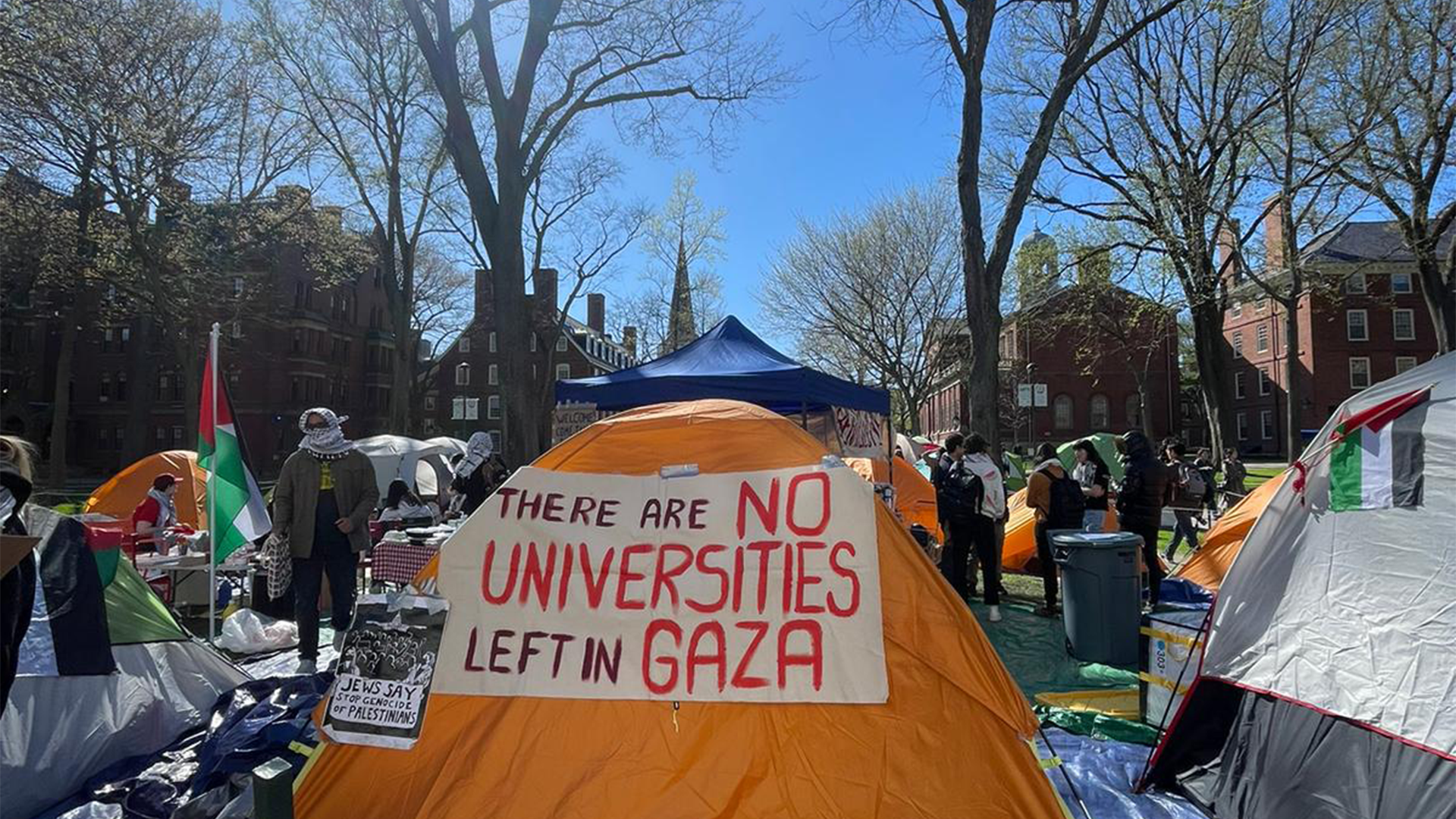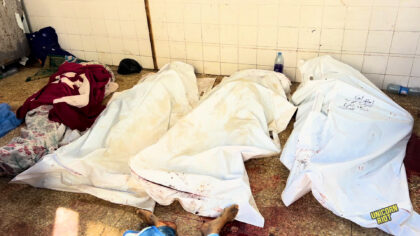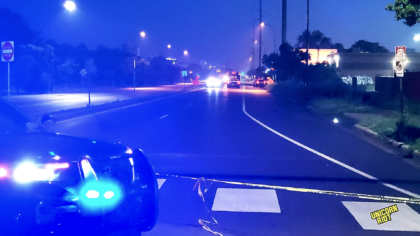From Boston to Palestine: Student Encampments Began in Peace and Ended in Handcuffs
Boston, MA — It’s impossible to think of Greater Boston without acknowledging the importance of its students and universities. Harvard University, the first college in the United States of America, is the most identifiable, often followed by the Massachusetts Institute of Technology. Boston University, Boston College, Emerson College, and Northeastern are other notable universities that attract students from all over the world. Therefore, when campus encampments sprung up across the country, it came as no surprise when many began in Greater Boston.
On April 21, 2024, students at Tufts, MIT, and Emerson began pitching tents on their campuses, declaring three different Palestine solidarity encampments.
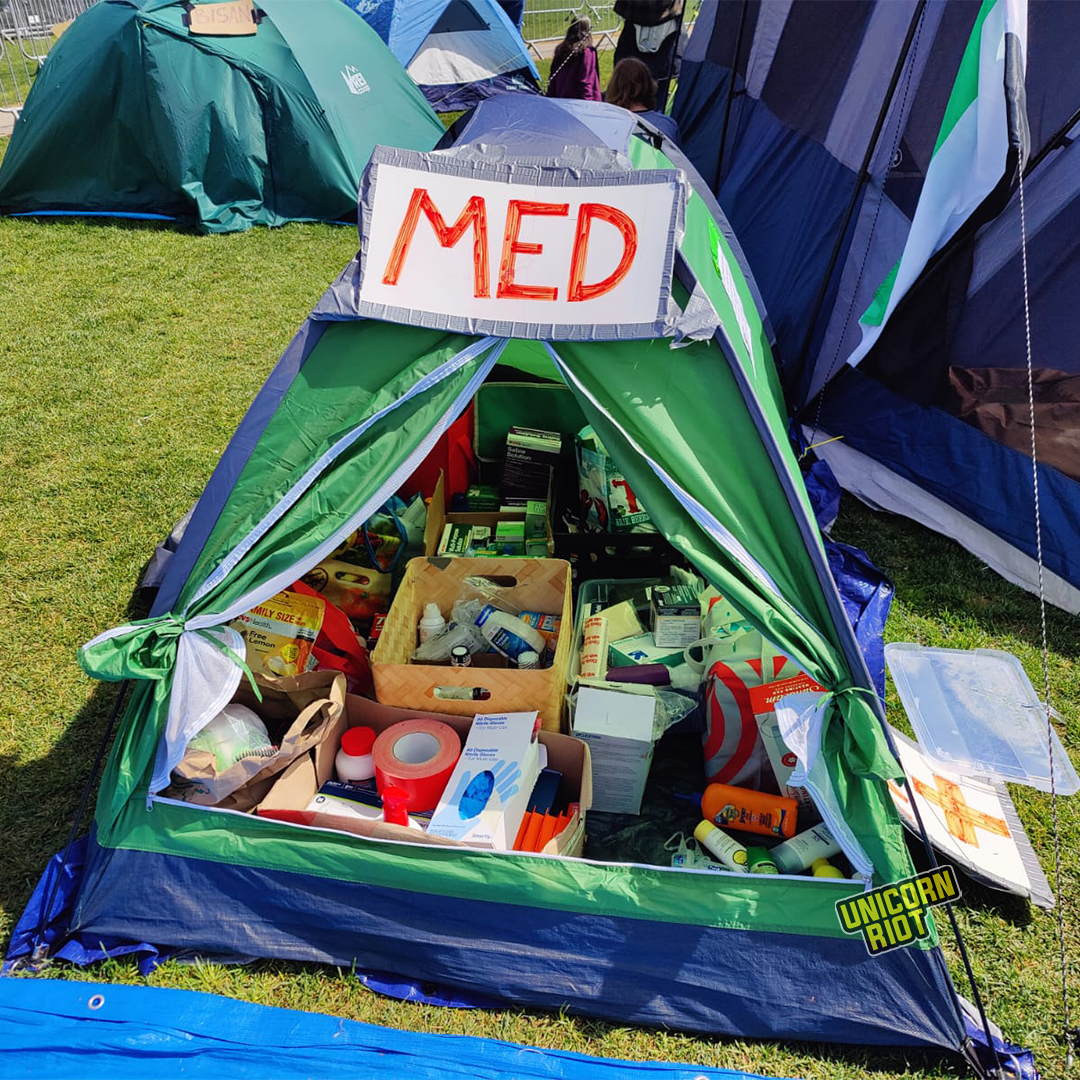
The encampments were fueled by student volunteers and community donations. They overflowed with tents, signs, and tables filled with food and drinks. Medics and medical supplies were provided, but there was also music, chanting, dancers, and art.
At Tufts, in Somerville artwork established separation and identity. A Palestinian flag, tied between two trees, flanked one section of the encampment. Most eye-catching were the murals. Students painted pictures of slogans and martyrs onto thick wooden boards, overturned tables, and signs, which were used to create a barricade and an entrance to the encampment.
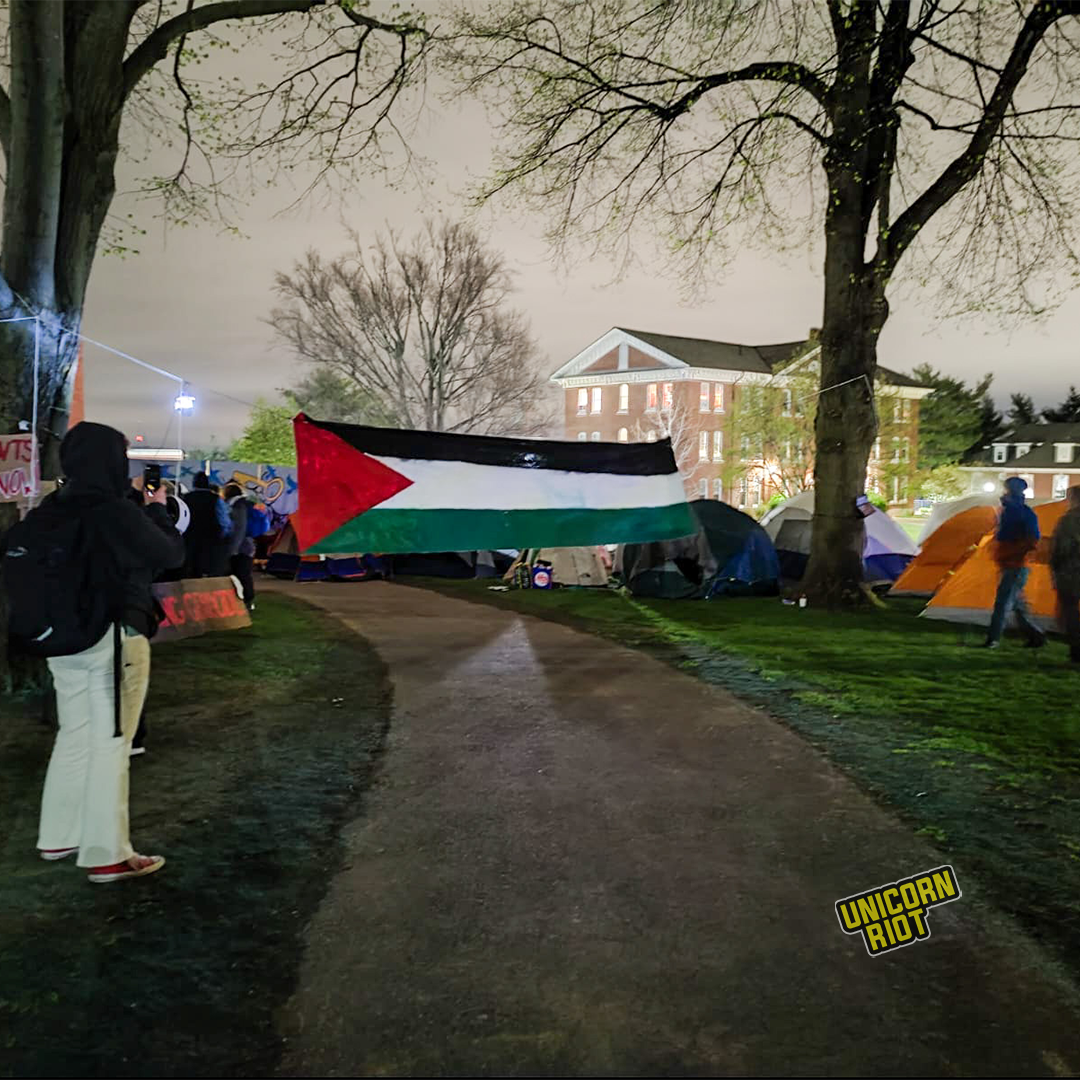
At MIT in Cambridge, students set up the Scientists Against Genocide Encampment. A fence surrounded the circular encampment, with openings to let people in and out. Seen from above, the encampment appeared like a human cell, organically allowing people to enter and exit a semi-permeable membrane.
Inside the encampment, tents were labeled with the names of towns, cities, and regions in occupied Palestine.

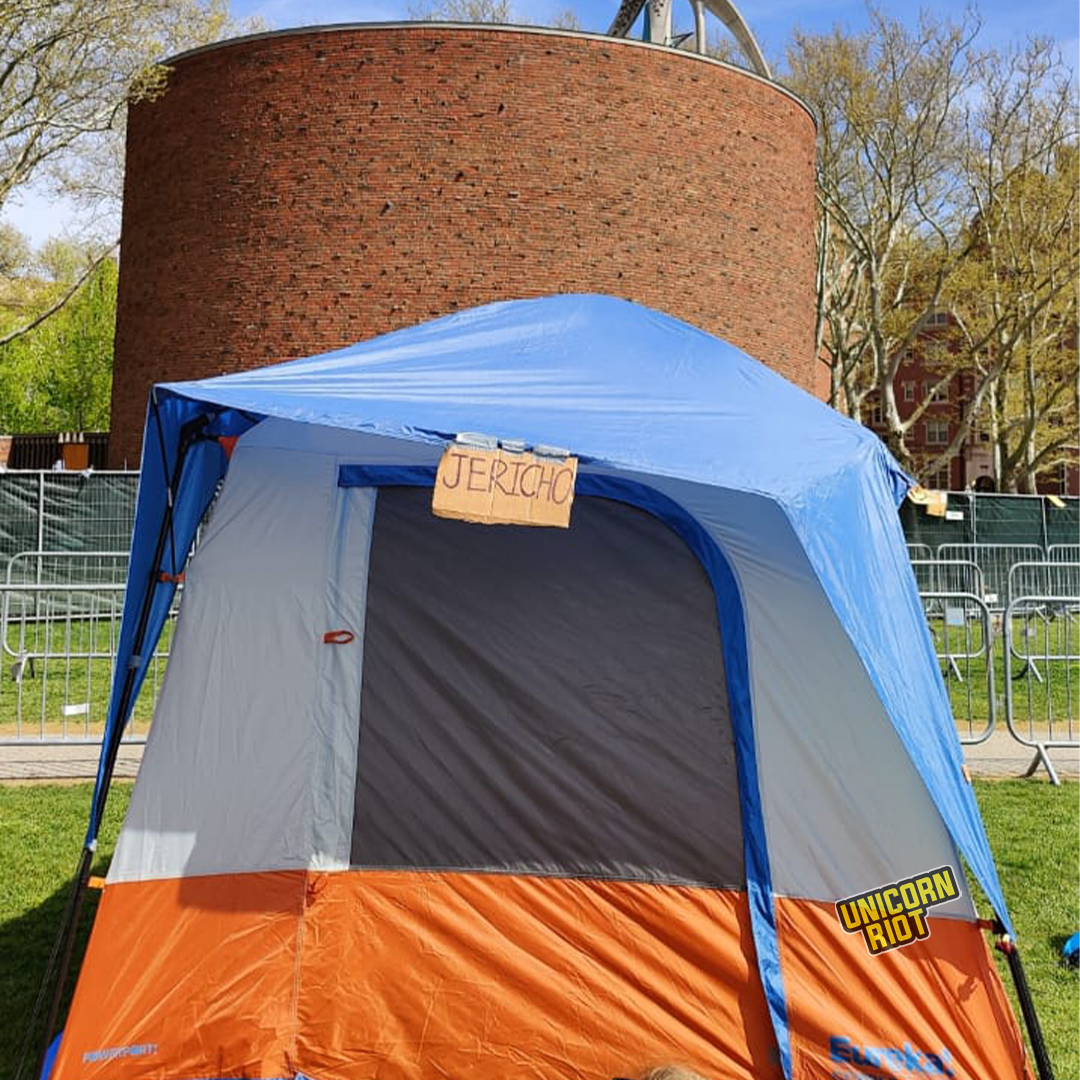
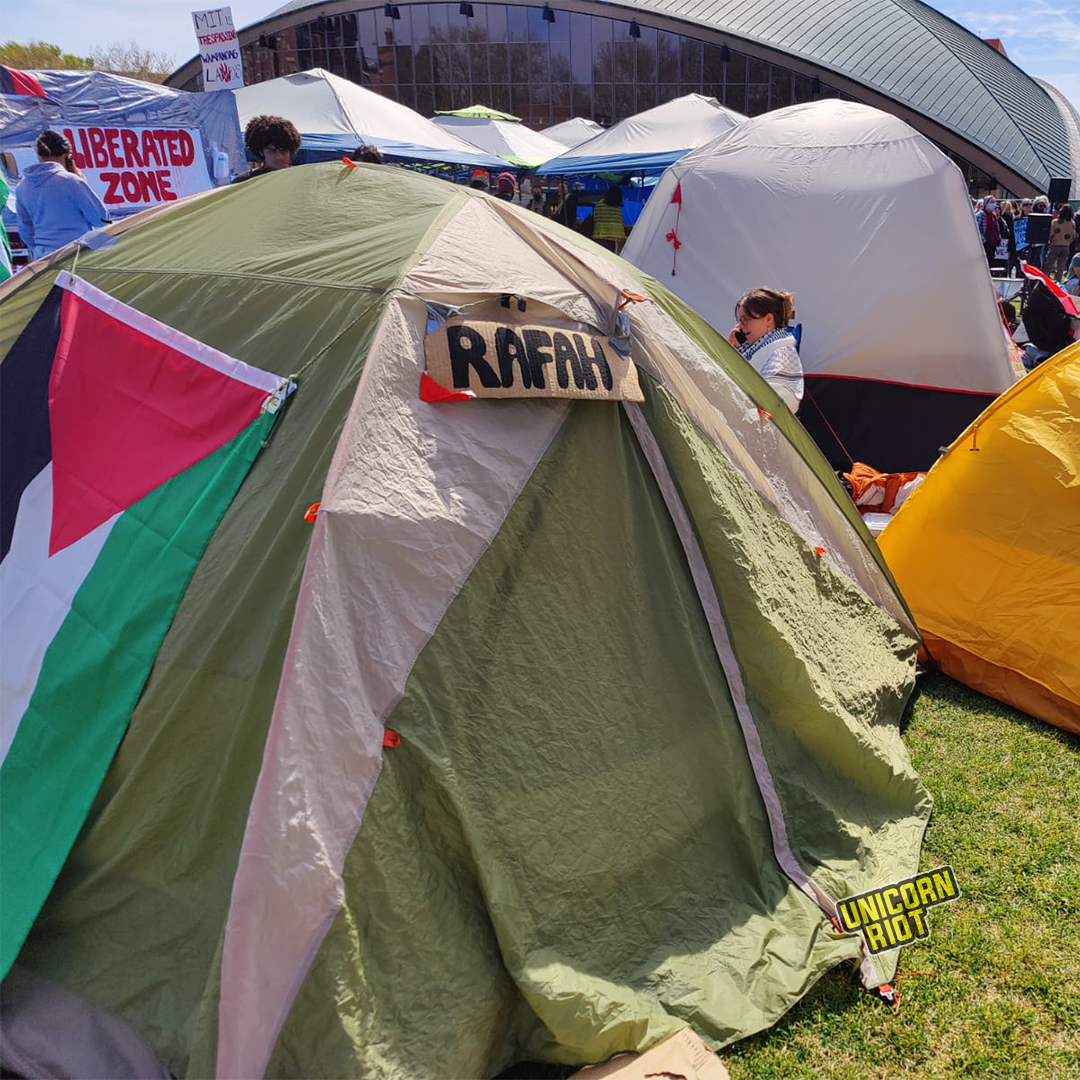
On May 10, the MIT Scientists Against Genocide Encampment was swept by police; students were arrested and the encampment was closed by force.
Emerson’s solidarity encampment was perhaps the smallest and most brutally repressed. Located in the heart of downtown Boston, Emerson held their encampment in an alleyway where a handful of tents were set up. Images and words drawn in chalk danced around the encampment, creating swirls, connecting the ground to the walls and the tents to the statues. Arabic music was playing in the background as members of the encampment gathered around two tables overflowing with prepared food, fruits, and dry goods. What Emerson lacked in size, it made up for in art, music, and community. The encampment had a speaker series where every few hours speakers would come up to give talks about Palestine.
Its intimate size did not, however, prevent it from being raided.
It was early in the morning on April 25 when the Boston Police forcibly broke up the encampment, arresting the protesters in attendance. As students were physically forced into police cars, the Emerson encampment ended, but the movement only grew.
A few hours after the Emerson students were arrested, Northeastern students set up camp on Centennial Common, a field next to the Ruggles Train Station.
The “North Eastern Liberation Zone” faced threats of police violence from its inception. As students gathered at 7 a.m. to build their tents, a line of police officers in full riot gear were waiting for them.
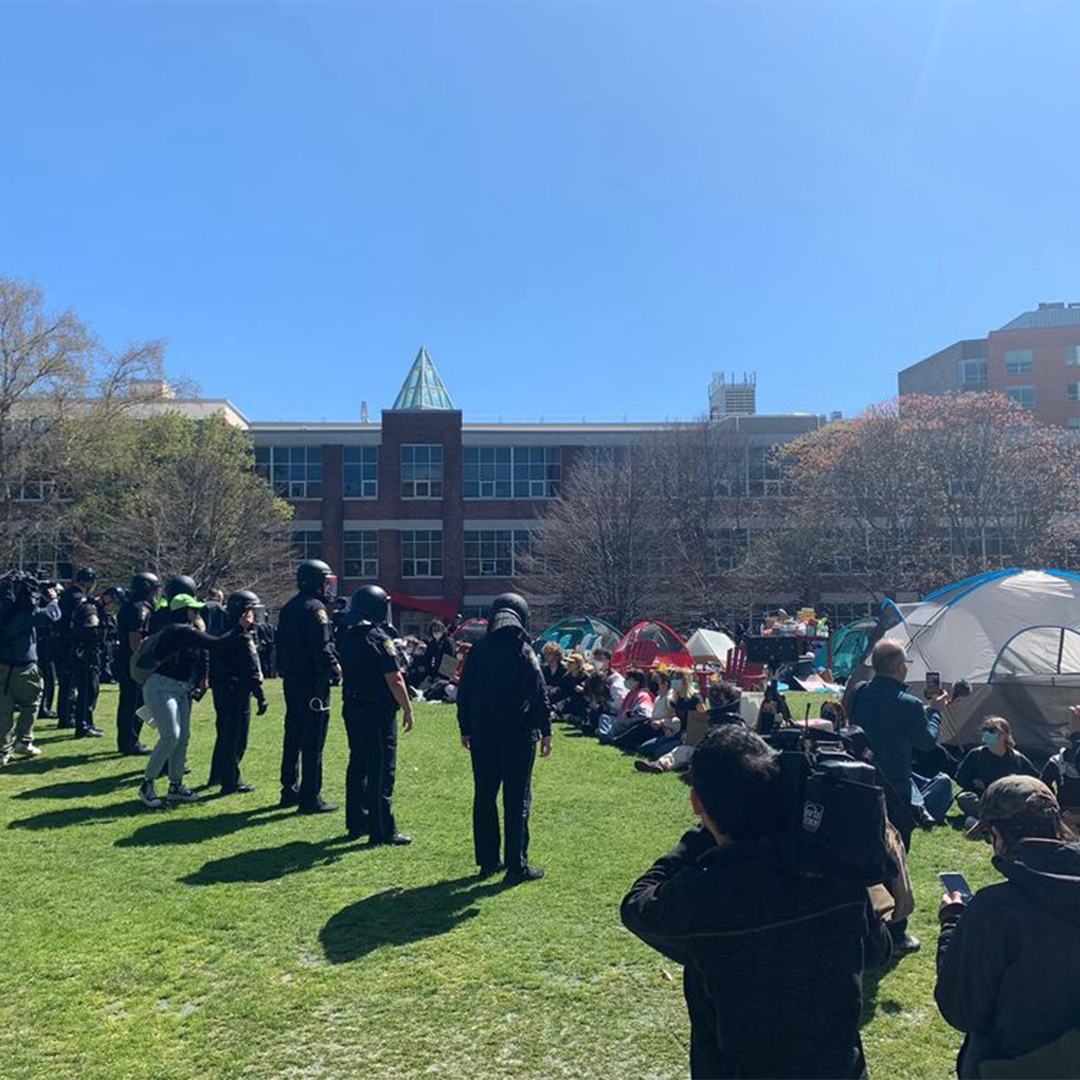
In the words of one protester:
“When I got here it was already heavily patrolled and there were a lot of police forming a perimeter and trying to single out, isolate and intimidate people. I was personally intimidated by multiple cops telling me that ‘if I were their kids they’d be pissed off … If you care about your future, you shouldn’t be here.’ They took my ID. They ridiculed me for having it taped up … It was just a lot of really, really demeaning scare tactics …
‘I know you guys are going to talk about me as soon as I leave … say it to my face. If I were your parents I’d be pissed at you.’ … I could feel the spit and the hate coming out of his mouth … This has been happening for hours.”
Despite their attempts at secrecy, the police had been tipped off about their encampment, and there were more cops than protesters.
Throughout the day, protesters increased. As the encampment grew threefold in the afternoon, the police dissipated.
“We think they were afraid of our numbers. They just wanted to intimidate the protesters and make us feel small. As we grew in numbers, most of them left,” the protester continued.
By 2:30 p.m., only a handful of police officers remained.
A line of pro-Palestinian student protesters created a chain around the encampment, holding signs, and responding to calls for a “Free Palestine.”
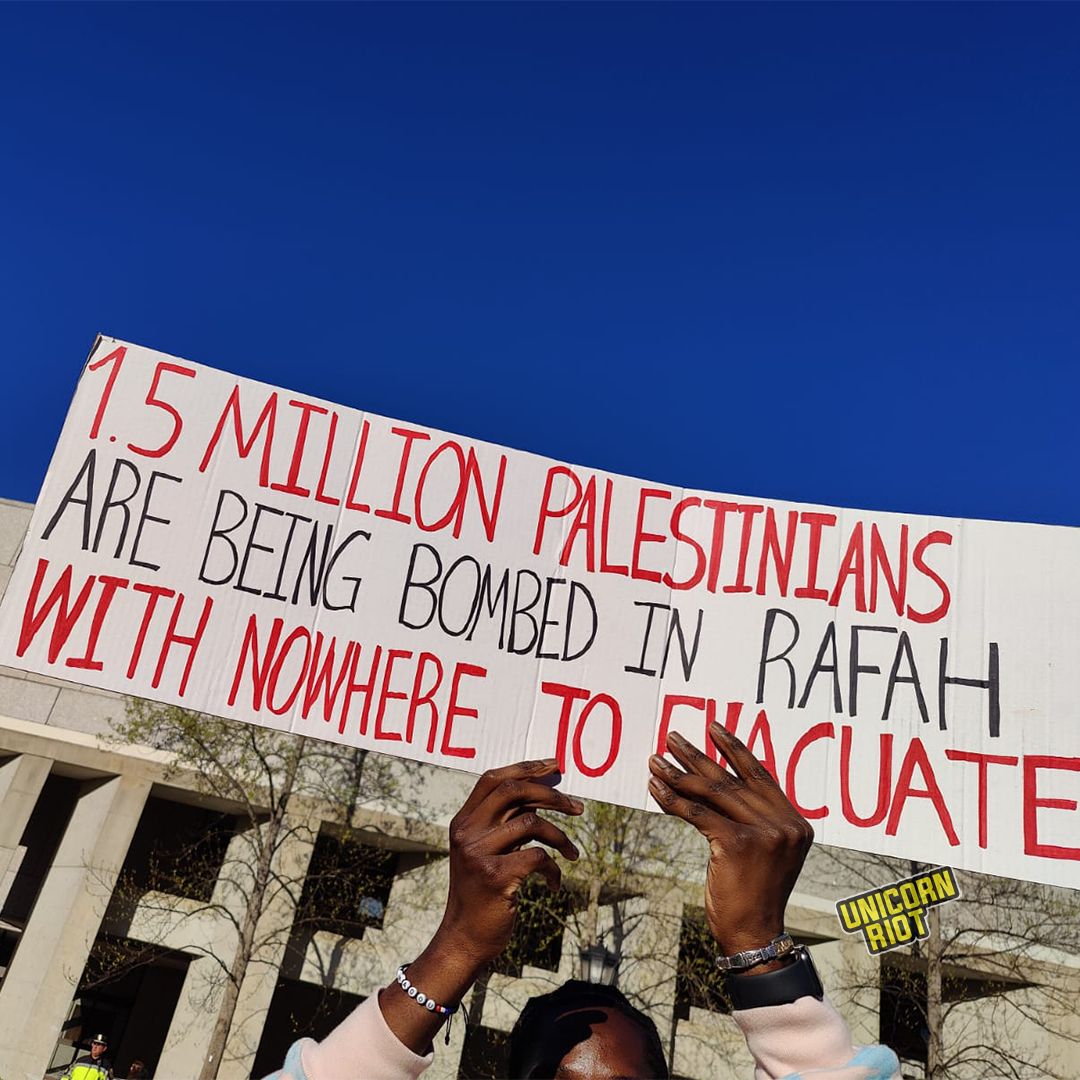
Inside the encampment there were a few tents, and people were singing and dancing to the beat of bucket drums. Many protesters were shouting slogans and chants as they stood in solidarity with the people of Gaza and covered part of the small park. Perhaps because of the ominous line of cops that had stood outside the protest in early hours of the day, crowds had gathered in large numbers to stand and shout their demands and calls to action.
By the evening, the camp calmed down and the protesters spent their first night on Centennial.
On April 27, two days later, the camp was shut down.
Hours before the camp was raided, the encampment had grown tense. Night had fallen, and the organizers heard a rumor that the police were going to shut down the protest.
A line of multi-colored lawn chairs encircled the encampment, replacing the chain of people, and creating a rainbow around it in the late hours of the night.
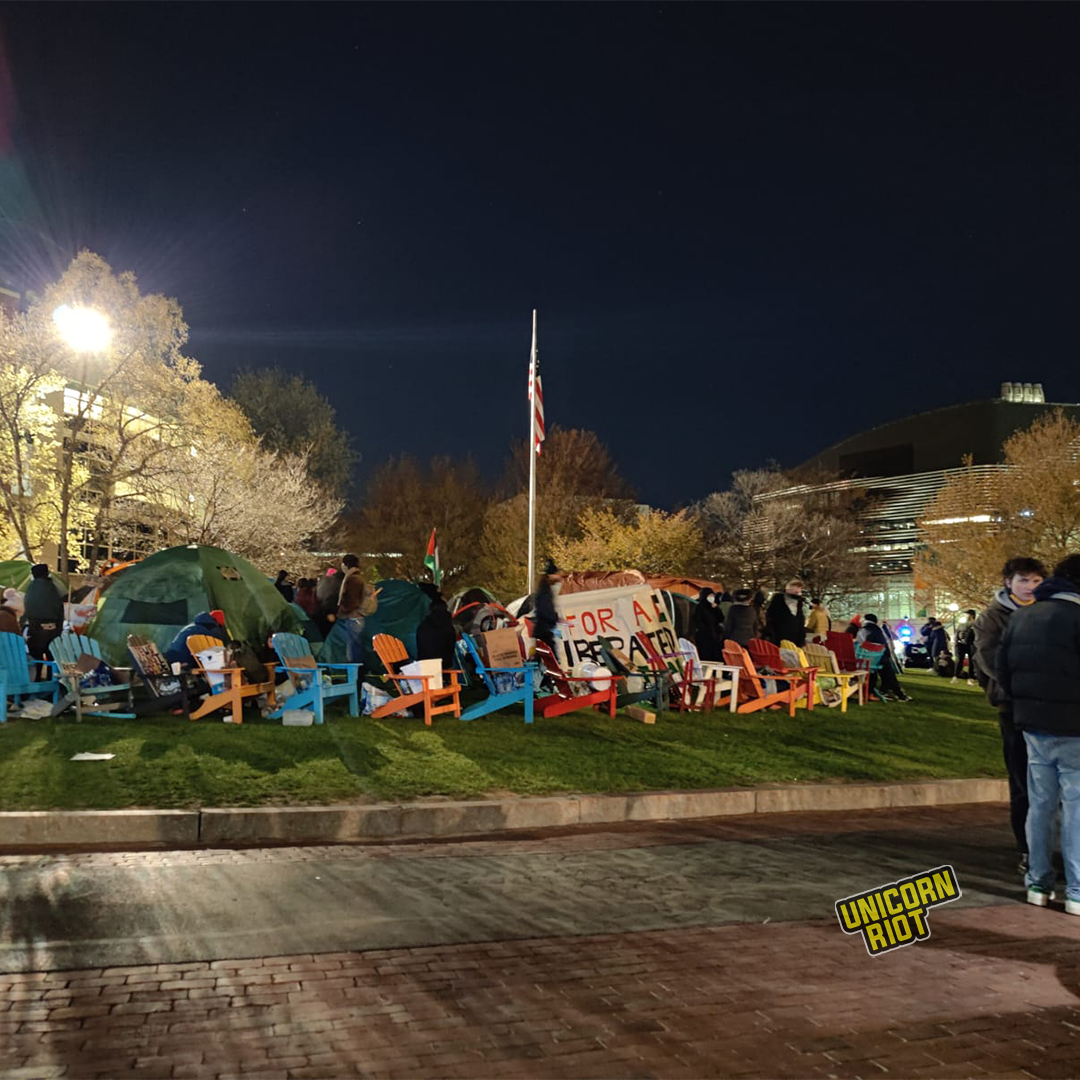
That night, a group of counterprotesters had embedded themselves near the center of the encampment. The counterprotesters stood on chairs, holding the Israeli flag, surrounded by pro-Palestinian protesters they were taunting. Earlier in the week, the counterprotesters had been non-combative; however, that night, things were changing. Video evidence shows the counterprotesters, identified as being part of the Zionist student group “Huskies for Israel,” in the middle of the crowd harassing Arab students and accusing the protesters of being immigrants funded by the foreign nation of Qatar.
One counterprotester called out:
“Kill the Jews! Anybody on board!?”
One of the encampment organizers later hypothesized that he was trying to provoke the pro-Palestinian protesters whom he assumed to be antisemitic.
Instead, he received boos in response.
As the atmosphere heated, the encampment marshals asked the crowd to move away from the counterprotesters and follow their voices. For the rest of the night, the Zionist protesters were mostly ignored and, for a few hours, a sense of peace and tranquility settled over the encampment.
As the night waned, police presence increased until nearly a dozen officers were around the encampment. By 3 a.m., students spotted moving trucks, and it was clear that the Northeastern University Police planned a raid. Around 5 or 6 a.m., the raid began. Police barricaded Centennial Common with metal fences so that no one could enter or exit the encampment.
Students were told that if they showed their Northeastern IDs and left, that they would not be arrested. Several of the pro-Palestinian students attempted to do as directed, showing their Northeastern IDs and leaving, but the cops arrested them anyway.
The rest of the protesters sat peacefully, agreeing amongst themselves that they would not resist arrest.
Police went around one by one, arresting and zip tying protesters’ hands behind their backs.
One protester found himself surrounded. Cops encircled him, shielding their actions from Northeastern’s many cameras. Inside the circle, they pinned him to the ground, twisting and forcing his hand behind his back. He screamed out that they were hurting him. They paid no heed. Tying his hands, they arrested him.
He and his fellow protesters were taken to Shillman, a hall at Northeastern where students were processed by campus police. Several students testified that they were treated disrespectfully and inappropriately during their processing, including one female student who spoke to Unicorn Riot about what she said was a sexual assault.
When she was brought into Shillman with her hands zip tied behind her back, a Northeastern Police Officer threatened that if she did not show her Northeastern ID, she would lose all her financial aid and be expelled from the university. Scared, the student turned to one of her friends and explained that she had placed her ID and inhaler inside her shirt, and that she wasn’t sure how she’d get it out, since her hands were zip tied.
According to the female student, one male cop laughed and said:
“Oh, don’t worry, we have ways of getting in there.”
The student was taken aback and upset.
The male officer, who the student described as “embarrassed,” took her to a female officer and said “Tell her what you told me” and left. The student explained her situation. Having seen other students have their zip ties removed, the student asked the female officer if she could remove her zip ties, so that she could get out her ID. Ultimately, the request to have the zip ties removed was declined by a male officer next to them and the female officer said “Sorry, I’m going to have to do this.” According to the student, the female officer then proceeded to lift her shirt and bra, touching her and searching for her ID in front of two male officers.
“I feel like I’m violating you now,” the female officer told the student.
“That’s because you are,” the student responded.
After the incident, she and the other arrested students were sent to Nashua Jail, where they were charged with trespassing and rioting. They spent several days in jail before being released. Transgender protesters experienced discrimination, as they were forced to go to the jail that matched the gender on their identification cards. Two male students of color were detained the longest, released from jail well after everyone else had already left.
On behalf of all the arrested students, and their collective experiences, the female student who said she was sexually assaulted by campus police stated the following:
“For a lot of these students, this was our first time getting arrested, our first time experiencing carceral, police violence. A lot of my comrades came out of this really traumatized, especially people who were experiencing excessive force or inappropriate conduct by the police. I keep calling it inappropriate conduct, but it is what it is, and it’s sexual assault. A lot of us did come out of this with new traumas and it’s all NU’s fault. And I think if you write this piece, that’s the one part I would really like to make clear: that all the newest trauma that we are dealing with — the fact that sexual assault happenned in Shillman, in NEU, by police officers that were sicked on us by NEU admin — that’s a responsibility that they have to bear. That they should be ashamed of.”
After the arrests were made, Northeastern University sent out the following message:
The chant to “Kill the Jews” was said by a Zionist counterprotester, but the pro-Palestinian protesters were blamed, and no Zionist protesters were arrested.
The protest itself, like all of the encampments sweeping the country, was student-led. As governments and universities began to crack down and arrest protesters, some were quick to identify the influence of “outside agitators” and “professional protesters” as a justification for calling in the police. Former police officer-turned mayor of New York, Eric Adams, claimed the Columbia University protests were infiltrated by “outside agitators” and then used this as justification to arrest more than 200 students in New York.
“We kind of always laugh when people say ‘outside agitators’ because it’s just community members coming, because they are also enraged. Like how can you see what’s happening and not be enraged and not be moved to do something?” said one of Northeastern’s arrested student protesters.
At least 96 people were arrested for protesting at Northeastern. In addition to criminal court hearings, Northeastern students are required to go through an independent academic hearing process which could lead to academic repercussions including, for some, suspension.
In the last month, Harvard University placed 20 of their students on academic probation and suspended five for participating in the Harvard Out of Occupied Palestine Encampment. One hundred eighteen students were arrested at Emerson during a violent confrontation between students and Boston police officers, and 10 students were arrested at MIT.
According to the New York Times, more than 3,000 protesters have been arrested nationwide for protesting at universities against an assault on Gaza, which the International Court of Justice has called a “plausible genocide.”
The amount of attention encampments receive instead of Gaza was unsettling to some student protesters. One organizer of Northeastern’s Liberated Zone had this to say:
“I think a lot of the media has been centering the protests that are happening in the United States without realizing why those protests are even happening to begin with … It’s really important for us as students in the West to use the privilege that we have to advocate for what’s happening in Gaza and to center their stories.”
The protester who said she was sexually assaulted related her personal interactions with law enforcement to people in occupied Palestine:
“As soon as the cops knew that eyes weren’t on them, they decided that it was appropriate to touch me or to touch my other comrades. Or to use excessive force. As soon as they knew that those cameras were not on them, they got bold. It was interesting to have to come to terms with what was happening with me at the moment and also really conceptualize what must be happening to Palestinians under occupation. When less coverage is on Gaza, when less coverage is on Palestine, the bolder they feel with inflicting violence.”
At Northeastern today, there may no longer be an encampment, but student protests for Palestine face increasing repression. Since the encampment was destroyed, all public action for Palestine is policed. In the last month, every encampment in Greater Boston has shut down or closed. Students continue to protest for a ceasefire in Gaza, though hundreds still face disciplinary actions from their universities and court hearings from being arrested.
At Harvard University, where students voluntarily shut down their encampment, thirteen students were not allowed to graduate as punishment for their participation in Harvard’s Gaza solidarity encampment. On April 23, hundreds of Harvard students walked out of their graduation with Palestinian flags and signs, chanting for a “Free Palestine.”
For many pro-Palestinian students in Greater Boston, repression has become the status quo. Student encampments have sparked anti-war activism across the United States and the world. And yet, in the heat of the movement, the House of Representatives overwhelmingly passed a bill called the Antisemitism Awareness Act, which could make future Palestine solidarity encampments illegal.
Within this uncertain future, one expression has become popular amongst students: “Palestine will free us, too.”
Cover image by metajournal
For more from Palestine and pro-Palestine protests click on image below.
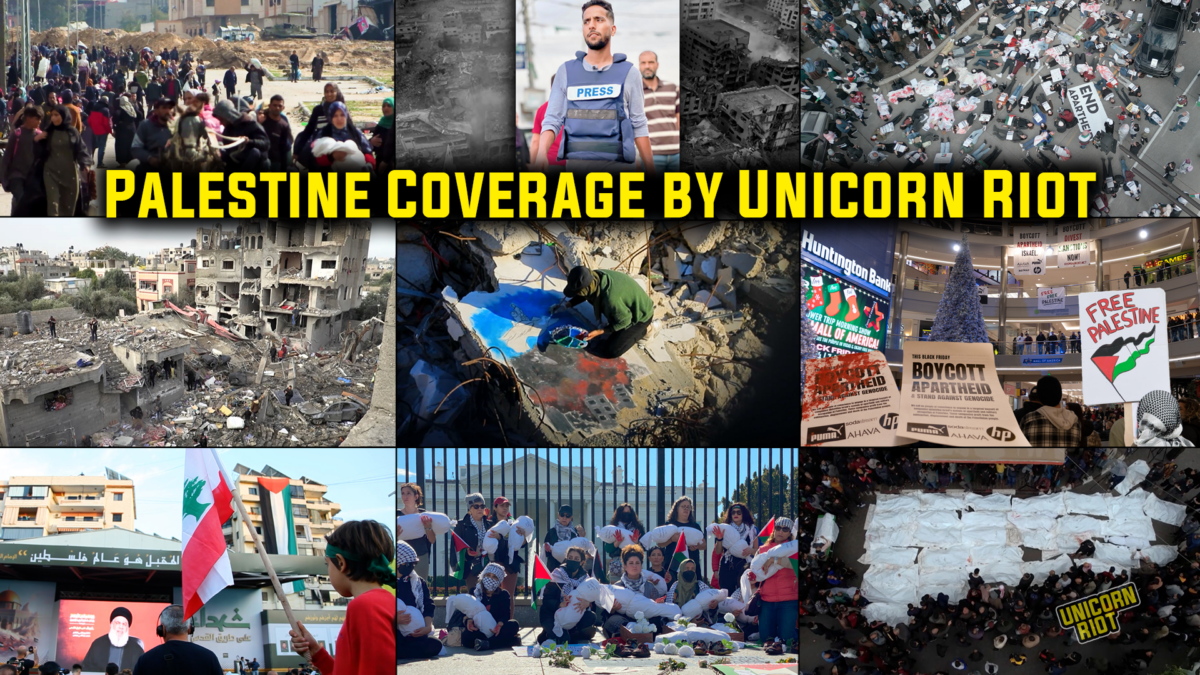
Follow us on X (aka Twitter), Facebook, YouTube, Vimeo, Instagram, Mastodon, Threads, BlueSky and Patreon.
Please consider a tax-deductible donation to help sustain our horizontally-organized, non-profit media organization:

